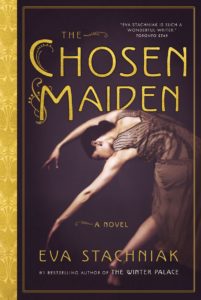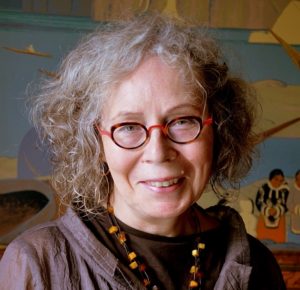Interview with Eva Stachniak
 How did you come across this story? What inspired you to write about it?
How did you come across this story? What inspired you to write about it?
The Chosen Maiden was born out of my fascination with Ballets Russes, a Russian dance company which, in the summer of 1909, took Paris by storm. Bronislava (Bronia) Nijinska –the intended Chosen Maiden from the 1913 production of The Rite of Spring choreographed by her famous brother Vaslav–was my inspiration. A brilliant dancer and a ground-breaking choreographer, herself, Bronia lived a life fuelled by art and made possible by the fierce loyalty of the Nijinsky women who stood by each other through thick and thin. The Chosen Maiden is what I like to call an archival fantasy, a historical novel weaved together from facts and imagination, an intimate portrait of a woman whose art and life helped to define what it means to be modern.
What were your main sources for your research? How did you organize everything? (That is, got any tips for fellow writers?)
Bronislava Nijinska died in California in 1972 leaving behind rich personal archives. Her papers–160 boxes of them–found their way to the National Library of Congress. This is where I spent long hours reading diaries, notes, letters, as well as looking at hundreds of personal snapshots Bronia took of her family and friends. To organize this material I turned to my favourite writing tool, Scrivener, which lets me keep all related files in one project and organize them into clearly distinguished and easily accessible categories. When I finally began to write, these notes contained all I needed: descriptions of historical characters and places related to the story, details of dances and performances featured in the novel, as well as images which guided me through the most important moments of the story.
What were the biggest challenges you faced either in the research, the writing, or structuring the plot?
I have to confess that the richness of the archival material was both a blessing and a curse. After all I was not writing a biography of a famous choreographer but a novel. In order to hear the voices of my fictional characters I had to forcibly step away from all the material I have collected, let my own vision emerge. This took time and confidence which I gained by interviewing contemporary dancers and getting to understand the way they see the world. In the end–after several drafts– I struck the right note: true to the recorded facts, but also free to express my own understanding of Bronia’s story and its meaning.
Every writer has to leave something on the cutting floor. What’s on yours?
The story of Olga Kokhlova, Picasso’s first wife. Olga was a Ballets Russes dancer, one of Bronia Nijinska’s closest friends from before World War I. The story of that early friendship belonged to the novel, but I soon found myself writing long passages about Olga’s troubled and often tragic relationship with Picasso. It took me quite some time to admit that, however compelling, this relationship was not relevant to Bronia’s own story, and had to go.
Tag you’re it! What historical fiction author do you most admire? Why?
Ami McKay writes historical fiction which blends together fantasy, magic realism and meticulous research. Ami’s inspiration are unconventional women who find their strength in female solidarity. Her latest novel, The Witches of New York, has just been published and I would like to hear her answers to the questions I have just answered.
Now forward these questions to him/her and we’ll share their answers next week!
 Eva Stachniak is the award-winning and internationally bestselling author. She holds a PhD in literature from McGill University. Born and raised in Poland, she moved to Canada in 1981, and lives in Toronto. The Chosen Maiden is her fifth novel.
Eva Stachniak is the award-winning and internationally bestselling author. She holds a PhD in literature from McGill University. Born and raised in Poland, she moved to Canada in 1981, and lives in Toronto. The Chosen Maiden is her fifth novel.

